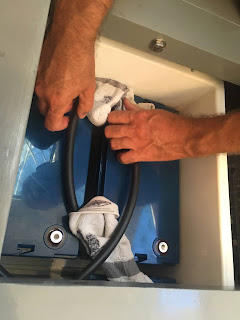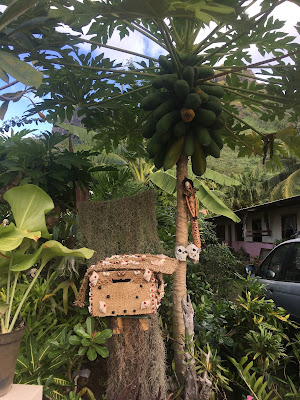 |
| What an idyllic spot for such a project |
batteries stop reading now. If you think you might be interested in batteries find something better to do with your day !
We have lived full time on Askari since 2016 and have rarely been in a marina. The last time we had mains power on the boat was in January 2020 so we have built some experience about how to manage our electricity needs. By August 2021 the Covid 19 Pandemic was surging again in French Polynesia and we were at anchor in Bora Bora when two things happened. Our diesel generator stopped working and the government announced a likely new lockdown. This was going to make it tricky to fix our generator as the parts we needed were not available locally.
 |
| The old batteries in their neat box |
We knew our house battery bank was getting old and we had been managing it carefully with our generator. Batteries on Askari get worked hard with big loads from the microwave and air conditioning. We normally run the generator twice a day for one hour to take care of our batteries (we always maintain a minimum state of charge of 60%). Without a generator this was now a problem. After almost 6 years of ‘abuse’ we had no complaints and set about finding replacement batteries. We planned to buy identical batteries that we could drop in. This however proved difficult, so we were faced with a choice between buying “unbranded” Gel batteries in Tahiti that didn’t fit in the existing battery box, or make the switch to Lithium batteries.
Following discussions with other cruisers that had personally reconfigured their systems to Lithium technology we were convinced to make the switch to Lithium. Thanks in particular to Andy on SV Tintamarre and Josh on SV Agape for sharing their experiences and for their encouragement.
 |
| Plan A...... |
During the build of Askari in 2015 we considered fitting Mastervolt Lithium Ion batteries as they would give us more useable capacity than conventional Lead Acid batteries. The price premium for Lithiums at that time though was enough to convince us otherwise and we installed 600 Ah of Sonnenschien Gel batteries (essentially 6V golf cart batteries wired in pairs to give us 600 Ah at 12V). We knew from our experience cruising on ReVision II that quality Gel batteries could last many years – when we sold her they had done 20 years although no aircon or electric cooking on that boat.
We did however expect that in the future Lithium batteries would become more affordable, so we made sure that our systems and equipment was “Lithium ready”. The heart of Askari’s power distribution is a Mastervolt Ultra Combi which puts out 3000 W of 230V power from our house batteries and charges our batteries at up to 150 A when the generator is running or in a marina. It also handles up to 30 A from our solar panels too although solar alone isn’t enough to run Askari.
Without a working generator we were reliant on the two alternators on our main engine for some of our power needs. We run two alternators with serpentine belts mounted either side of the engine. We had supplemented the stock Yanmar 125 A alternator with a second, externally regulated Mastervolt 90 A alternator. Both alternators have internal temperature sensors which de-rate the output if the alternator gets too hot. Normally the Mastervolt alternator charges the house batteries and the Yanmar alternator charges the start and thruster batteries via a battery mate. We have the option to connect all the DC systems together with a switch so we can effectively use both alternators to charge the house bank.
The management of all this is through a Mastervolt shunt and sensors to a monitor with alarms and preprogramed events. We can view and program everything with a laptop connected to the Masterbus.
 |
| We only had crayons for kids to colour the diagram for cables |
All of these systems were working well and allowed us to run the boat as we wanted. It meant we carefully monitored the voltage and state of charge of our batteries and manually connected circuits and disconnected at the right time to get the fastest charge times when motoring. With the generator running the combi charger manages all this automatically. We had no interest in adding further complexity simply to replace old batteries for new. We also had a neat battery installation in a battery compartment under the floor complete with extraction/cooling fan. We knew that the Mastervolt Lithium batteries wouldn’t fit in the existing box so were not in our immediate plans as a solution.
On Saturday Carolyn called Michel at Tahiti Yacht Accessories- he’s quite a character but said we were in luck as he had six 100 Ah Victron Lithium batteries in stock. We were doubly surprised when he told us the price which was competitive with European prices. They would even fit inside our existing battery box with only a few modifications. On the Monday Carolyn called Michel with a credit card number. On Tuesday Michel made up some new battery cables for us and put the batteries on a ship to Raitea. Wednesday morning we collected the batteries from the ship in our dinghy and took them to Askari. (They may have been lost under the cheesy puffs for an hour or so but we finally got them).
 |
| 7am we are looking for the batteries |
 |
| They are in here under the cheesy puffs |
 |
| They are here! |
We simply followed the setup instructions provided by Victron Energy, the battery manufacturer. We charged each battery to full which is hold at 14.2 V for two hours. We then connected them up on the cabin sole to test them before we started taking apart the existing bank. We changed all our equipment settings so that the batteries would be charged at 14.2 V until full and then after 2 hours the voltage is reduced to 13.5 V. At the time the new generator part had somehow been lost in the Ivory Coast so we couldn’t fully test everything, but we established that the batteries would charge with the solar and alternators and we could run all our onboard equipment. Our generator is up and running again now.
 |
| Charging each one |
 |
| Testing the whole bank - we made changes to the cable runs after this |
On Thursday we removed the old gel batteries and set them up on the cabin sole so that we could power the boat whilst we modified the battery box and secured the new Lithium batteries. By Friday the job was complete; and all systems were running smoothly. That’s it three days at anchor and the job was complete, and if we hadn’t got distracted by beer and burgers one afternoon it would have been quicker.
 |
| Old bank running out of the box |
 |
| We used socks to protect the terminals |
Two months later we have had no issues and are enjoying some significant benefits:
- We have mostly decoupled battery charging from power usage. This is because we now can safely discharge the Lithium batteries significantly more than our old Gel batteries so our available power is double what it was. This means we run the generator less often and at a time we choose so life on board is generally quieter.
- Many of our electrical systems run better, especially fans, motors, pumps and SSB radio because our new batteries have a more stable voltage under load. We are now almost always at 13-13.2 V rather than 12-12.4 V under load. It’s a bit more efficient too.
- Our total generator time has reduced because we are always charging the batteries at the maximum battery charger output of 150 A right up to full. Some appliances like the washing machine have a variable power offtake (i.e. when heating the water) so it makes sense to run this from the batteries rather than the generator or else there are times in a washing cycle when the generator isn’t fully loaded. This wastes energy. The battery power for a 60 minute wash can be replaced with 20 mins of generator charging for example. Previously we mostly ran the generator when the washing machine was running.
- The charging process is very efficient so 10 amps in almost equals 10 amps out. Before, losses were more than 10% so now it doesn’t matter when we charge up because the efficiency is almost 100%. Those losses generated heat which was wasted energy so our batteries which used to get warm when charging are now almost the same temperature all the time.
We learned a few things that may or may not be applicable to other boats
- Our internally regulated 125 A Yanmar alternator reduces power output when hot (as does our 90 A Mastervolt externally regulated alternator). They work without any issue either linked together or independently. The Yanmar alternator is always connected to the AGM starter battery as this protects the alternator from voltage spikes. When we parallel the batteries to boost charging we can charge at 100 A continuous (150 A peak) at normal cruising speed. Bigger alternators might be better but we don’t see the value right now as our generator is fixed. We were advised not to use the Yanmar alternator for charging the Lithium batteries and to buy a new alternator or a B2B charger. We use a manual switch to link them together and to separate them and have experienced no issues with this. We simply monitor the battery voltage and state of charge and connect/disconnect as required. We have tested what happens when the batteries reach full charge with both alternators connected and simply the Mastervolt alternator switches off and the Yanmar alternator goes to float at 13.8 V which is too high for long term storage of the Lithium batteries so I tend to unlink the circuits before full charge. I think we would run out of fuel before we damaged the batteries by forgetting to unlink them!
- Victron make two different Lithium battery products.
o We have Victron Superpack batteries which have internal protections (internal BMS) for each battery which disconnect the battery if a fault develops or sensors identify a problem. Victron Superpack batteries were essentially a drop-in solution for us. Other than some system setting changes and the physical install there was nothing else to change on Askari.
o Victron Smart batteries are very different from Victron Superpack in that they need to be controlled by a separate battery management system. The two products have quite different features and benefits.
- We have set up audible alarms on our Masterbus which we think will be compliant with future standards being proposed. I feel being hardwired and permanently connected is better than relying on wireless options. I already sleep with the phone by the bed, if I could monitor the temperature of an internal cell in my batteries by Bluetooth in the middle of the night I would. Not sure what I would achieve from that other than less sleep. In addition to audible alarms our Masterbus switches off charging and inverting circuits at conservative levels with respect to the battery internal BMS settings. To date we have had no alarms or events which gives us confidence that the system has been operating well within specification.
- On Askari our new Lithium batteries charge at about the same rate as the old Gel batteries did up to about 85% full. If we charge to 100% full each day we get a 20% reduction in generator hours. If we had bigger chargers available, the benefit would be greater (because our charger and alternators always ran flat out up to ~85% full). If we had a 300 A charger rather than 150 A maybe we could cut generator hours by 50% but that would fully load the generator so some things we normally do at the same time like making water might be delayed. I guess you get nothing for free, the power you use has to be replaced somehow.
- The wiring is the same size as the original build and is protected by the same fuses and distribution unit. The heat generated during charging and discharge is much less than with the old batteries and is approximately 2 Centigrade at 150 A.
- The automatic fan on the battery fan is controlled by a voltage sensitive relay from the battery bank. This is now an ineffective control as the voltage of the new batteries doesn’t change enough when being charged to work well. The sensor needs to read from the starter battery and this is on the job list to be fixed. This is the only issue we have found from the whole installation.
- I still have to run the generator to start the dive compressor because the inrush current is too much for our invertor.
- We were able to recycle our old batteries to another user in Raiatea which was a good way to finish the job.
- Our project was straightforward, and we are pleased with the end-result. If the new batteries last ten years then we will be in front financially. Time will tell.
 |
| Monitoring the systems |
 |
| Charging to the max right up to full |
Like most projects on a boat you will get three different opinions from three different captains.
There are captains that have employed a company to do the job and they have been sold a bunch of things that they believe they needed.
There are captains that design and do the job themselves but buy branded kit as it gives them confidence that the solution will work- that’s me.
And there are captains that build the components themselves and they will tell you how much money they saved.
Anyway, we found that there’s so much information and opinion out there that the hardest part of the task was sorting out fact from fiction. If you are thinking of taking on a project like this then its not difficult, just do your own research and make your own informed decisions.
 |
| La Pirogue for burger and beers |
Note from Carolyn – Thank you Andrew - always direct and to the point – while he’s been playing with this project I learned to make sourdough bread, which I cook electrically so I’m happy. I also like putting the washing machine on while I drink my morning coffee rather than kick starting the day as the generator is on so all things electric need to get going. The place we did this project was anchored of La Pirogue resort in Raiatea and its super stunning. Ps I’m pretty proud of my battery geek







































